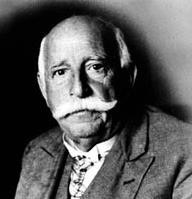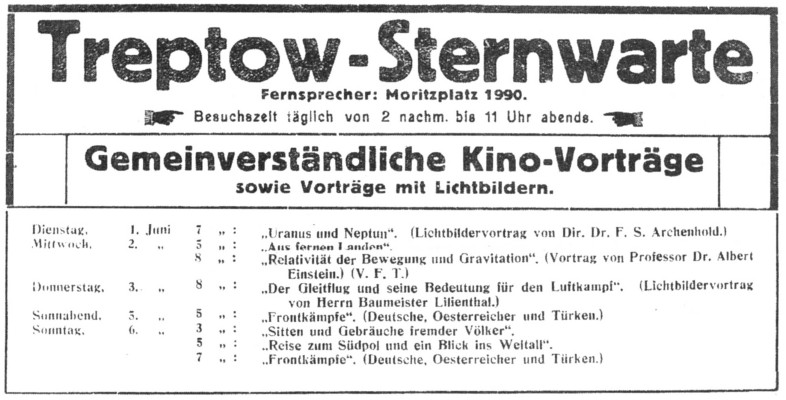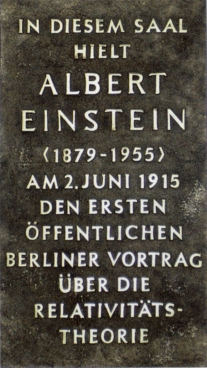Die Sternwarte möge ein Haus sein,
“von dem aus immer neues Licht hinausstrahlen und immer neue
Erkenntnisse ihren Weg zu jedem einzelnen im Volke finden mögen.”
The observatory shall be a house,
“from which a new light shall continuously shine out and ever
new findings shall always find their way to each individual among the people.”
Friedrich Simon Archenhold, Das Weltall 9, 1908/09
ALBERT EINSTEIN AND FRIEDRICH SIMON ARCHENHOLD
Albert Einstein‘s first popular scientific speech in Berlin about the theory of relativity.
The founder and director of the Treptow Observatory (renamed Archenhold Observatory in 1946) was Friedrich Simon Archenhold (1861-1939). He had dedicated himself to an intensive scientific research work, which especially focused on the sun. He further wanted to promote the scientific education of the general public. He tried to achieve this among other things with exhibitions and public speeches in the Observatory. Though he did a large part of the public speech programme by himself he also succeeded in winning numerous famous scientists and researchers over to hold speeches in the Observatory. Among them were the geologist Alfred Wegener (1880-1930), the polar researchers Roald Amundsen (1872-1928) and Fridtjof Nansen (1861-1928) as well as the space pioneer Hermann Oberth (1894-1989).

However, the most famous scholar was doubtlessly the physicist Albert Einstein (1879-1955), who held his first public speech concerning the theory of relativity on Wednesday, June 2, 1915 in the large lecture hall of the Treptow Observatory in Berlin.

Einstein‘s speech had been announced with the title Relativität der Bewegung und Gravitation (Relativity of Motion and Gravitation) and was – according to a report of the Vossische Zeitung in its evening edition of June 3, 1915 – able to lure a “relatively large number of listeners”. We do not have any text or picture documents of Einstein’s speech, so that we only know through the article in the Vossische Zeitung (in German) what Einstein had said.

Einsteins Relativitätsprinzip.
Vortrag in der Treptower Sternwarte.
Wie es in der Mathematik keinen besonderen Königsweg gibt, so lassen sich auch die Einsichten in gewisse Grundfragen der Physik nicht ohne Kenntnis bestimmter naturwissenschaftlicher Tatsachen, nicht ohne Zuhilfenahme der Mittel der höheren Mathematik klar gewinnen. Was für das leibliche Auge das Mikroskop und das Fernrohr sind, das bedeuten in gewisser Beziehung Differential- und Integralrechnung für das geistige Auge. Will oder muß man auf diese Stützen verzichten, so kann man nicht erschöpfend erklären, sondern nur andeutend hinweisen.
In dieser Zwangslage befand sich gestern Prof. Dr. Albert Einstein, das jüngste Mitglied unserer Akademie der Wissenschaften, als er vor einer verhältnismäßig großen Zahl von Zuhörern in der Treptower Sternwarte die „Relativität der Bewegung und Gravitation“ erläutern wollte. Der Schöpfer oder Mitschöpfer des Relativitätsprinzips versuchte – unter Verzicht auf alle mathematischen Ableitungen – klarzulegen, wie Ort und Zeit nicht voneinander zu trennen, wie Längen und Zeiten vom Bewegungszustand abhängig sind; daraus folgt die Abhängigkeit gleicher Natur für alle daraus abgeleiteten anderen Begriffe. Es ist einleuchtend, daß wir von einer Bewegung erst dann eine rechte Vorstellung haben, wenn wir sagen, worauf sie bezogen ist. Erst dann kann die Bezeichnung Ruhe oder Bewegung einen Sinn haben. Es kann dabei gleichgültig sein, ob ein System selbst oder seine Umgebung in entgegengesetzter Richtung bewegt ist. Blicke ich vom Karussell aus auf einen Baum, so scheint sich dieser zu bewegen. Sitzt man in einem gut gefederten, ruhig fahrenden D-Zug, so ist es für gewöhnlich nicht möglich, zu bestimmen, ob man sich bewegt. Sieht man zum Fenster hinaus und erblickt einen zweiten Zug, so scheint der andere zu fahren. Nur Aenderungen der Geschwindigkeit, rasches Anfahren oder Bremsen bemerkt man, ferner Krümmungen der Bahn, da man durch die Zentrifugalkraft nach außen gedrückt wird. Auch die Bewegung der Erde in ihrer Bahn um die Sonne ist nicht mit unbedingter Sicherheit zu erkennen. Alle Bewegungen sind relativ.
Einstein zeigt in einer auch dem Laien verständlichen Weise, wie man mit Hilfe eines sogenannten Koordinatensystems sich die Bewegung veranschaulichen kann. Mit genügender Annäherung kann man die Erde selber als ein solches Koordinatensystem wählen. Es bedarf keiner übermäßigen Ueberlegung, um zu begreifen, daß mit Bezug auf ein gegen das ursprüngliche Bezugsystem (Erdboden) gleichförmig bewegtes System (Wagen) die Gesetze des Geschehens die gleichen sind, wie mit Bezug auf das ursprüngliche System (Erde). Wir haben hier das Relativitätsprinzip der gleichförmigen Bewegung, das Relativitätsprinzip im engeren Sinne. Gilt es aber auch – so fragt Einstein weiter – für die ungleichförmige, für die beschleunigte Bewegung? Im ersten Augenblick wird man die Frage verneinen. Aber Einstein zeigt, indem er, von zwei verschiedenen Bezugssystemen aus, das Fallen von Körpern beobachtet, daß der Beschleunigung ebenso wenig eine unbedingte physikalische Bedeutung zukommt, wie der Geschwindigkeit (der gleichförmigen Bewegung). Dasselbe Bezugssystem ist mit gleichem Recht als beschleunigt oder als nicht beschleunigt anzusehen; je nach der gewählten Auffassung hat man dann aber ein Schwerefeld als vorhanden anzusetzen, das zusammen mit dem eventuellen Beschleunigungszustand des Systems die Relativbewegung freibeweglicher Körper gegen das Bezugssystem bestimmt. Fast unbewußt entschlüpfen dem Vortragenden, als er die Verhältnisse im beschleunigten System klarlegt und auf dessen Uebereinstimmung mit dem Schwerefeld (Gravitationsfeld) hinweist, Ausdrücke wie Potential. Wir fühlen, wie durch die Relativitätstheorie im weiteren Sinne auch die Newtonsche Gravitationstheorie erweitert wird.
Gibt es nun einen Prüfstein für die Richtigkeit dieser Anschauungen? Der Lichtstrahl oder vielmehr seine Geschwindigkeit muß das Kriterium abgeben. Nicht nur im beschleunigten System, auch im Gravitationsfeld muß er gekrümmt verlaufen. Seine Ablenkung (Aberration) wird zwar sehr gering, aber immerhin unsichtbar sein. 1) Aufnahmen von Sternen, die neben der Sonne erschienen, zur Zeit der Sonnenfinsternis, können Aufschluß geben. Freilich kann die Ablenkung nur außerordentlich klein sein, bei der Sonne 0,85 Bogensekunden, bei Jupiter gar nur 1/100 Bogensekunde. Mit Hilfe empfindlicher Apparate läßt sich aber eine solche Messung durchführen. Im Auftrage der Akademie der Wissenschaften sollte der Astronom Dr. Freundlich während der letzten Sonnenfinsternis solche Messungen durchführen. Aber der Krieg verhinderte diese Forscherarbeit, die für unsere Erkenntnistheorie nicht minder wichtig ist, als für die Fortentwicklung der Physik. Dr. Freundlichs kostbaren astronomischen Apparate wurden in Odessa beschlagnahmt, ruhen wahrscheinlich dank den „Kulturträgern des Ostens“ auf dem Meeresgrund. Aus Beobachtungen bei Sonnenfinsternissen Schlüsse über die Gültigkeit des Relativitätsprinzips zu ziehen, müssen wir uns vorläufig versagen. 2) Aber eine andere optische Erscheinung, das sogenannte Dopplersche Prinzip, kann die Entscheidung liefern.
Wenn es auch nur Andeutungen waren, die Einstein – in der knappen Spanne einer Stunde – geben konnte, so hatte es doch einen hohen Reiz, hineinzublicken in die Gedankenarbeit unserer modernen Physiker, zu sehen, wie sie unser Weltbild – wenn auch nicht einfacher – so doch einheitlicher gestallten wollen. el.
Quelle: Vossische Zeitung, Donnerstag, 3. Juni 1915, Nr. 279, Abendausgabe
1) Richtig muss es „sichtbar“ heißen.
2) Die am 29. Mai 1919 von dem Astronom Arthur Stanley Eddington (1882-1944) beobachtete Sonnenfinsternis bestätigte Einsteins Vorhersage der Lichtablenkung im Gravitationsfeld der Sonne, die er in seiner allgemeinen Relativitätstheorie postuliert hatte. Einstein wurde über Nacht berühmt. Der Mythos Albert Einstein war geboren.
Translation – The original text was written in German!

Einstein‘s Principle of Relativity.
Speech in the Treptow Observatory.
There is no special silver bullet in mathematics and also the insights in certain basic questions of physics cannot be clearly won without any knowledge of certain scientific facts and without the help of means of higher mathematics. The visible realities are the microscope and the telescope, however, the unvisible realities are in a certain way the differential and integral calculus. If you want to or must renounce these means you cannot sufficiently explain, but only point out suggestingly.
Prof. Dr. Albert Einstein, the youngest member of our Academy of Sciences experienced this dilemma yesterday, when he wanted to explain the „Relativität der Bewegung und Gravitation“ (Relativity of Motion and Gravitation) in the Treptow Observatory to a relatively large number of listeners. The inventor/co-inventor of the Principle of Relativity renounced all mathematical derivatives and tried to explain why place and time cannot be separated and how length and time depend on the state of motion. This means that all derived terms are dependent in the same way. It is plausible that we only have an adequate idea of the term ”motion“ if we indicate what it refers to. Only then can the terms ”silence“ or ”motion“ make any sense. However, it is not important whether a system moves itself or whether its environment is moved in the opposite direction. If I ride on a carousel and look at a tree the tree seems to move. If you sit in a well-suspensed express train which is driving calmly, it is normally not possible to say whether you move. If you look out of the window and see a second train, the other train seems to move. You can only detect changes of speed, a fast start-up or breaking as well as the train driving around curves, as the centrifugal force pushes you outwards. The motion of planet earth in its orbit around the sun can also not be detected with absolute certainty. All motion is relative.
Einstein shows in a way, which is also understandable by the general public, how motion can be demonstrated with the help of a so-called coordinate system. With a sufficient approach the earth itself can be chosen as such a coordinate system. You do not have to think a lot to understand that with reference to a system (carriage), which is evenly moved against the original reference system (embankment) the laws of the event are the same as with reference to the original system (earth). This is called the principle of relativity of uniform (even) motion, the principle of relativity in the narrower sense. However, Einstein questions, does it also apply to the non-uniform, i.e. to the accelerated motion? In the first moment the answer is no. But Einstein shows with the help of two different reference systems for falling bodies that the acceleration has as little absolute physical importance as the speed (the uniform motion). The same reference system can with the same right be considered as accelerated or not accelerated. Depending on the chosen opinion you have to consider the existence of a gravitational field which together with the possible acceleration state of the system determines the relative motion of free moving bodies against the reference system. Almost unknowingly the lecturer mentions terms like ”potential“ when he explains the relations in the accelerated system and points out its conformity with the gravitational field. We feel how also Newton’s theory of gravitation is extended by the theory of relativity in the wider sense.
Now – is there a touchstone for the correctness of these theories? The ray of light or rather its speed must be the criterium. It must be bent, not only in the accelerated system but also in the gravitational field. Its deviation (aberration) will only be very small, but at least invisible. 1) Pictures of stars, which appeared next to the sun at the time of the solar eclipse, can give information. Of course the deviation can only be extraordinarily small, in case of the sun 0.85 arc seconds, in case of Jupiter even only 1/100 arc second. However, with the help of sensitive devices such measurement can be performed. On behalf of the Academy of Sciences the astronomer Dr. Freundlich was ordered to perform such a measurement during the last eclipse of the sun. However, war came in between and hindered such research work, which for our epistemology is equally important as for the development of physics. Dr. Freundlich‘s valuable astronomical devices were seized in Odessa and – thanks to the ”cultural institutions of the east“ are probably laid to rest on the seabed. We therefore have to admit that observations at solar eclipses can at the moment not bring any findings about the validity of the principle of relativity. 2) However, another optical appearance, the so-called Doppler Effect, can be the foundation for the decision.
Although Einstein could only give hints in this short time of only an hour, it had a high attraction, to get an insight into the thoughts of our modern physicists, to see, how they want to shape our picture of the world – not simpler but more uniform. el.
Source: Vossische Zeitung, Thursday, June 3, 1915, No. 279, Evening Edition
1) The correct wording must be ”visible“.
2) The solar eclipse on May 29, 1919, which was observed by the astronomer Arthur Stanley Eddington (1882-1944), confirmed Einstein‘s prediction of the deviation of light in the gravitational field of the sun, which he had postulated in his general theory of relativity. Einstein became famous over night. The myth Albert Einstein was born.
It is remarkable that Einstein was ready to talk about his current research work to a lay audience, as the general theory of relativity was at this point of time not yet finished. But he made every effort to explain his thoughts in an understandable way, that means if possible without any technical terms and formulas. Already on April 26, 1914 Einstein had reported about the main thoughts of the general theory of relativity in the morning edition of the Vossische Zeitung in a longer article with the title “Vom Relativitäts-Prinzip” (About the Relativity Principle). It was written in a general understandable form. In this time began probably also the relationship between Einstein and Archenhold, who had published several articles about the work of Albert Einstein in his magazine Das Weltall.

Even after the antisemitic malicious campaigns against Einstein had begun, Archenhold did not drop the idea of an objective reporting about Einstein’s works. Therefore, until ca. 1933, approx. 30 articles were published in the magazine Das Weltall about the theory of relativity and its consequences for astronomy.
Thus the film “Die Grundlagen der Einsteinschen Relativitätstheorie” (The Einstein theory of relativity) by Hanns Walter Kornblum (1878-1970), which almost without any exception consists of trick shots, was shown in the Treptow Observatory for the first time on April 2, 1922 with an accompanying and explaining speech.
After Einstein‘s speech in the Treptow Observatory a collegial and friendly relationship developed between Einstein and Archenhold. They met each other among other things at meetings of the Physikalische Gesellschaft (Physical Society) or also in Einstein‘s flat in Haberlandstraße 5 in Berlin. Thus Einstein’s back then housekeeper reports that Archenhold was often there and gave her free tickets for speeches in the Observatory. Einstein and Archenhold talked about and discussed new und future-oriented projects, but Archenhold did not succeed in winning Einstein over for these projects, as for example for the large Mars exhibition of the years 1926/27, which took place in the Observatory. Einstein, who in the meantime had become a famous person, recognized that Archenhold’s intention was mostly using his famous name. He commented his denial with the words that he did not want to appear “überall als symbolischer Leithammel mit Heiligenschein” (everywhere as symbolic bellwether with a halo).
Einstein and Archenhold had not only joint humanistic aims but also the desire to popularise science. Maybe also their joint Jewish roots played a role. Unfortunately we only have few documents and letters, from which we could learn more about the relationship of the two men.
Friedrich Simon Archenhold died in Berlin on October 14, 1939 shortly after his 78th birthday. With the coming to power of the Nazis began also the expulsion of his Jewish family. Archenhold‘s wife and coworker Alice as well as his daughter Hilde all died in the concentration camp in Theresienstadt. The sons Günter and Horst could emigrate to England. In December 1932 Albert Einstein and his family left Germany for good. He found a new home in Princeton, New Jersey, USA.
On occasion of the 100th birthday of Albert Einstein the big lecture hall of the Archenhold Observatory, in which Einstein held his first public speech about the theory of relativity in Berlin on June 2, 1915, received in a ceremony on March 15, 1979 the name Einstein Hall. At the same time a bronze was revealed next to the entrance of the hall, which was designed by the Berlin sculptor and bronze caster Hans Füssel (1897-1989).
In the ceremony, in which participated among others the Borough Mayor, the City Counsel for Culture and public figures, the back then director of the Archenhold Observatory Dr. Dieter B. Herrmann held a speech about “Einstein, Archenhold and the popularisation of natural sciences”. The theoretical physicist and astrophysicist Prof. Dr. Hans-Jürgen Treder (1928-2006) opened the evening.

Illustrations credits:
Courtesy of the Archenhold-Sternwarte Berlin-Treptow: 1, 2, 3, 4
Bibliography:
| Dieter B. Herrmann | Blick in das Weltall Die Geschichte der Archenhold-Sternwarte | Berlin 1994 |
| Dieter B. Herrmann | Einstein und Archenhold: zwei Vorkämpfer für die Popularisierung der Naturwissenschaften | Weinheim 2005 |
| Vossische Zeitung, Morgen-Ausgabe | Albert Einstein: Vom Relativitäts-Prinzip | 26. April 1914 |
| Vossische Zeitung, Abend-Ausgabe | Einsteins Relativitätsprinzip. Vortrag in der Treptower Sternwarte | 3. Juni 1915 |
| Friedrich Herneck | Einstein privat Herta W. erinnert sich an die Jahre 1927 bis 1933 | Berlin 1978 |
| Editors: A. J. Kox, u.a. | The Collected Papers of Albert Einstein, Volume 6 | Princeton 1996 |
| Wolfgang H. Günzel | Berliner Bronzen Brücken Bauten Geschichten aus dem Leben des Berliner Metallbildhauers und Bronzegießers Hans Füssel | Berlin |


 DEUTSCH
DEUTSCH